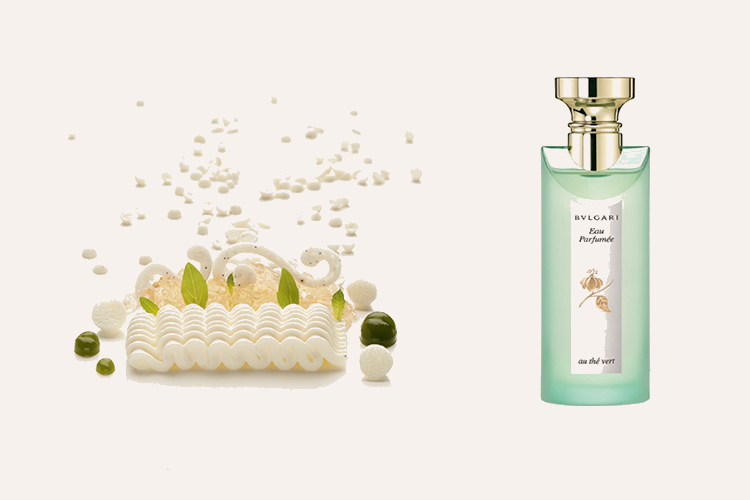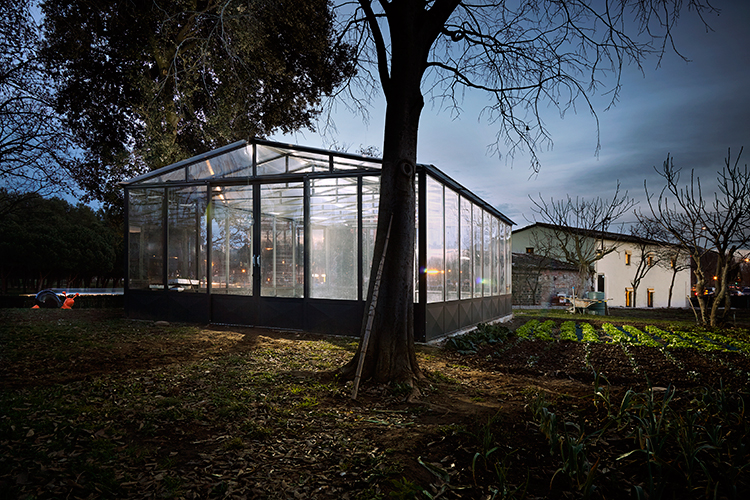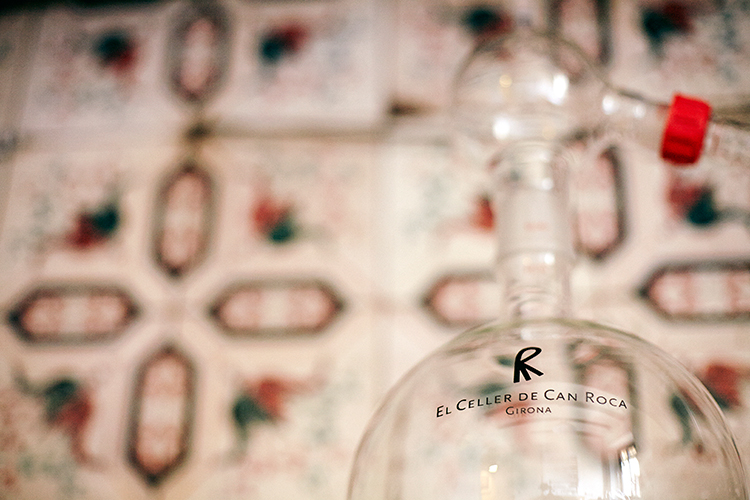Jordi Roca, the youngest of the Roca brothers and best pastry chef in 2014 according to the magazine ‘Restaurant’ is a ‘dessert-man’ with a great sense of humor. We interviewed him and talked to him about it what most passionate him, cooking and gastronomy, but also we talked about art, sustainability and travelling. From Magazine Horse we have chosen Jordi Roca as the character that identifies with the value of November: EXPERIENCE, for his ability to offer unique and unforgettable experiences through his desserts.
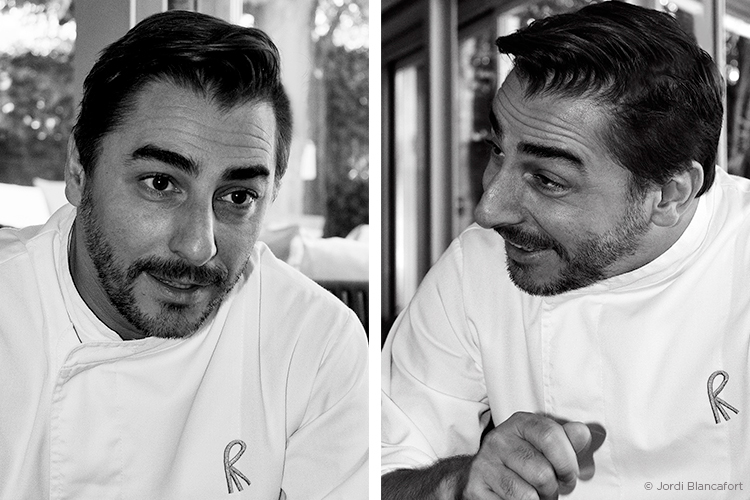
Jordi Roca with the jacket of El Celler de Can Roca
He defines himself as a dessert-man, is an avowed addicted to ice cream and also a fan of anything that has a funny or weird point. In Magazine Horse we have had the opportunity to meet Jordi Roca in the two environments in which he spends most of his days: with his impeccable white jacket of El Celler de Can Roca, (3 Michelin stars 1995, 2002, 2009 and best restaurant of the world in 2013 and 2015) and in his personal project of ice cream parlor Rocambolesc, that runs alongside with his wife Ale Rivas.
In his dishes, there is not a lack of artistic and cultural references, being the journey one of his biggest sources of inspiration. He does not forget either his roots and constantly draws on childhood memories when preparing his desserts. Like his brothers Joan and Josep he eats every day at Can Roca, the traditional restaurant of his parents who conveyed the three children love for the simple, generous and honest cuisine. “It is a way to put your feet on the ground,” says Jordi Roca, “because success is very nice to live but it also can be hard”.
For the youngest of the Roca brothers, sustainability is, without a doubt, the future of cuisine. Aware of its importance, at the end of year he plans to consolidate (with Joan and Josep) the Roca Brothers Foundation, as a way of bringing together all projects designed towards environmental responsibility and social awareness. For his values, unique personality and incredible creativity and talent that he shows both in cuisine and outside it, in this interview is shown that Jordi Roca is a chef almost from other planet.

Jordi Roca at Rocambolesc poses with one of his books
HORSE: Rocambolesc is a fun, fresh, simple ice cream parlor with a high demand for quality and that seeks to bring a smile to all public. Did you always have a clear concept of the ice cream parlor you wanted?
JORDI ROCA: Yes, Rocambolesc is the open window of the Celler pastry to everyone, that is, the sweet world of Celler available to all. What we want is to make smile, to make an age range of 3 to 100 years have fun. We try to captivate the children’s part, we want to make dream. In addition, they are always ice cream with a lot of history behind; each composition comes from a dessert of the Celler and has a reason. There is the entire palette, from the naive part to the most conceptual, but above all it is fun.

Jordi Roca poses in Rocambolesc with a popsicle made from a mold in the shape of his nose
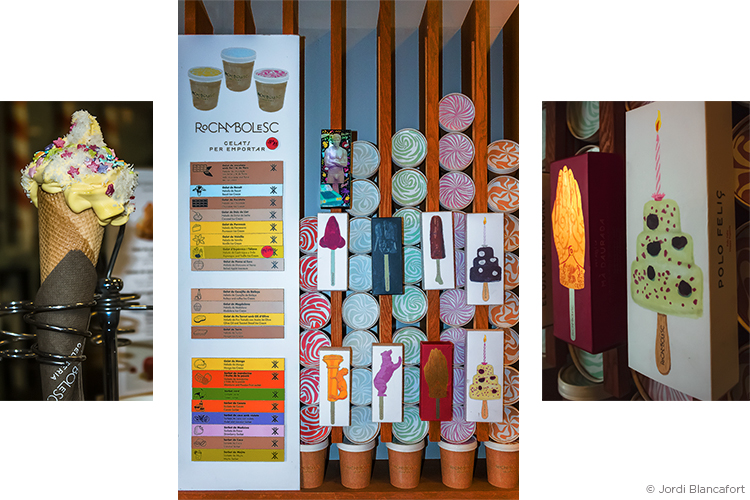
Variety of ice cream available in Rocambolesc
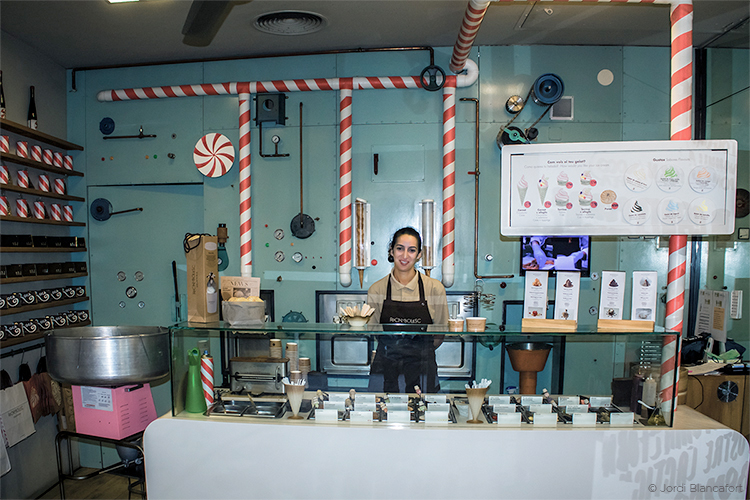
‘Charlie and the Chocolate Factory’ inspires the aesthetic of the Rocambolesc ice cream parlors
HORSE: In every city where you have opened a Rocambolesc, you have devised a special popsicle that pays tribute to a monument of that city. What monument or icon of what city you would love to turn into a popsicle?
JORDI ROCA: The popsicle thing is something that comes after, once everything is aligned to open a Rocambolesc here or there. In Barcelona, we made the finger of Christopher Columbus with chocolate, which is the best legacy that we get from America, and we gave it a Mediterranean-style with olive oil and salt. In Madrid, the Bear and the Strawberry Tree, in Girona the Cul of the Lleona and the last thing we did was the Velencoco, which is a monument of Tossa de Mar, but much more original and fun.
Some rare monument that I would like to turn into a popsicle could be a very original gargoyle of a lion eating an ice cream that is at the University of Salamanca. It is something historic and would be ideal for getting marriaged to the lioness of Girona.
HORSE: You claim to be addicted to ice cream, of which you say it was and is happiness. What ice cream did you always ask for when you were a kid and what is your current favorite of Rocambolesc?
JORDI ROCA: When I was a kid, I loved the Dracula, the iconic ice cream of Minnesota cream and coke.
The one I like the most of Rocambolesc is the last that we have made of apple, lemon and cucumber, which is a very refreshing, very aromatic sorbet and very grateful to eat. What usually happens is that the one I like the most is always the last we have done.
HORSE: You said Eternity of Calvin Klein and Journey to Havana are the desserts that you feel prouder, and you define Anarchy as a dessert that has it all. Is the best dessert you ever eaten yours?
JORDI ROCA: Whenever I make a new dessert, I try that it would be the best dessert possible. However, as you travel you find fascinating things. For example, in Chile we tried a very good dessert with Chilean fruits, cherries, sapodilla and many aromatic motifs wrapped in candy, of the confectioner Gustav of the Restaurant 99, which was recently chosen the best pastry chef in Latin America. I have also models of desserts by Albert Adrià, in Tickets we tried an innovation of a cheesecake with a lot of magic and a very cool finish. I could not tell you just one.
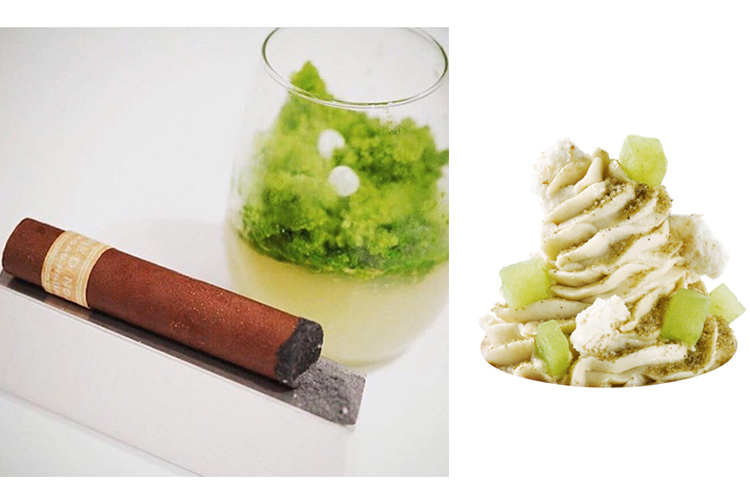
Left Photo: ‘Journey to Havana’ was the first dessert of Jordi Roca at El Celler. Right Photo: The sorbet of lemon, basil and green apple is his favorite of the Rocambolesc
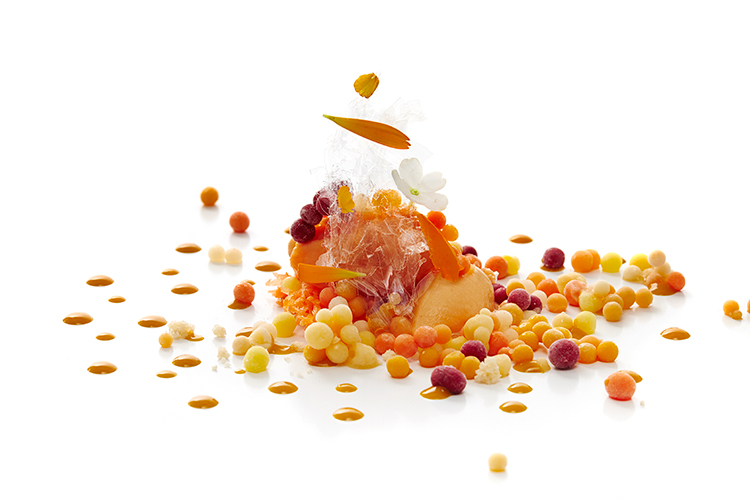
Dessert ‘Orange Cromatism’ by Jordi Roca
HORSE: How did come to your mind to start making desserts with smells of perfume?
JORDI ROCA: It is easy to understand when a sommelier, in this case Josep, tastes or smells a wine with nuances. He has a great olfactory memory and knows how to relate it with things that come from the cuisine, he says: “here, we have peas of Greece, passion fruit, cacao and truffle”. Then we ask ourselves, “why not to make a dish with these nuances that come from wine?” We tried different dishes, they were really good and they worked, so that is how it began a new creative way from this relationship between food and wine.
Once we went backwards, a new ingredient came, bergamot, a citrus fruit that we did not know a type of very fragrant lemon, which is used to make many perfumes. When we asked ourselves what it smelled like, we saw that there was a perfume which had this aroma: Eternity by Calvin Klein, which has vanilla, tangerine, orange blossom… We tried everything on a dish and it was brutal, it worked. They were two great revelations: one, that perfumes started from edible things and two, that it would have been hard to have gathered all that on a dish without going through seeing what was in that perfume, what was behind. The next day I went to Sephora and I discovered a whole world.
HORSE: It is like eating a perfume?
JORDI ROCA: The dishes have all the elements of a perfume. It is a little like playing to be a perfumer from the gustatory point of view as reference.
The Miracle of Lancôme is a ginger cream with grapefruit, roses, lychee sorbet and a candy of pink pepper. When you eat this dish from top to bottom, you incorporate everything and in your mouth, the elements appear in a sequenced form. We want to have an aromatic sequence: body notes appear first and then tertiary notes. In every spoonful you perceive the lychee, the strawberry of the forest, the rose, violet, ginger and pink pepper, in a very aromatic way, like a perfume, but there is no perfume, everything is taste. What we do is putting a scented stick with the perfume next to the plate; so that you can smell the dessert you have eaten and recognize it after.
“I am playing to be a perfumer from the gustatory point of view as reference”
HORSE: Memories, smells and journeys are three elements that you usually resort as inspiration. Could you give us an example of each one that you have used or that you have in mind for your next dessert?
JORDI ROCA: A dessert from a childhood memory would be a popsicle of Rocambolesc called Dark Ice Cream and that is inspired in the Dracula ice cream. We wanted to rescue its legendary scent of coke with a popsicle that is made with blueberry, vanilla and strawberry jelly. We named it Dark Ice Cream because it has the face of Darth Vader, is the joke of “the dark side”.
From the journeys and smells, I could say the last one I made from a perfume, called Turkish Rose and is from a local perfumer who we met on the last trip we took to Istanbul. It has cinnamon, saffron, roses, pistachio and peach.
Also the new Mona Easter for 2017 that we have decided to make from a trip to Easter Island. There, we discovered the legend of the man-bird. They made a competition on a nearby island where they had to go down a cliff climbing, take an egg, putting it ahead and go to the main island. The one who arrives with the intact egg, was the one who ruled. From this story, we have made a reproduction of an Easter moai with an egg on top and made with cocoa beans that we received from Peru.
HORSE: Is the power of nostalgia the secret of Celler de Can Roca?
JORDI ROCA: I think it is one of many. We say that nostalgia is our creative starting point because, although we do not want, we always recur to memories. We like to know where we came from , remember the roots to which we belong, it makes us part of a culture, of a place and of our family. It is to see nostalgia with innovation, not sad or melancholic nostalgia, we want to celebrate and share.

A corner of El Celler de Can Roca with photographs of the three brothers
“Nostalgia is our creative starting point because, although we do not want, we always recur to memories”

Entrance of the restaurant El Celler de Can Roca with its famous logo
HORSE: You eat every day in the traditional restaurant of your parents with the entire team of Celler. When you travel, you prefer traditional or avant-garde restaurants?
JORDI ROCA: Both, because through an avant-garde restaurant you can read much more between the lines. When you go to a restaurant with an advanced level in cuisine, you can see how the movement in that place is and, at the same time, where it comes from and where it has its sources. At the end, it happens the same in everything, we use memories, origin. Therefore, you can have all the country: history, traditions, products, etc. Obviously, the one who likes food, likes to eat a product as it is, but strolling around gourmet restaurants you can find all that too: the original product of a place as of the most advanced gastronomy.
“In an avant-garde restaurant you can see how the movement in that place is and, at the same time, where it comes from and where it has its sources”
HORSE: What technical difficulties you may find when making a dessert such as the Helado de Masa Madre (Sourdough Ice Cream)?
JORDI ROCA: It was born from our participation in El Somni, a multidisciplinary dinner at which interacted many arts. This was a dessert for a particular moment in which Adonis dies and his molecules gain the control of the universe. The dish is an ice cream of sourdough of fermented bread, a mass that lives and breathes which surprisingly does not die with bread. It was very funny because the idea of doing it in motion we found it walking in a store of items for home, in which there were small pets that breathed, false kittens and puppies that had a beating stomach. I bought two of each and we skinned them to see how they worked and emphasize more that moment. With Andreu Carulla, with who we work hard to design special and rare dishes, we saw how we could make this mechanism propulsion with batteries with a mass of latex, which simulates the bread dough as a body in motion.
HORSE: Your desserts stand out for their creativity and sense of aesthetic. What kind of references of the world of art and design have been the most influential in your cuisine?
JORDI ROCA: I really enjoyed discovering Kandinsky and his evolution. I saw an exhibition from his inception to his last work and I discovered that synthesis of colors, shapes, the elements of a picture and how to put them. It was like platting a dish without knowing it. It was the first with who I said I was interested in the art world, until then it seemed a little distant. Anarchy is inspired by him, is a dish that has many elements, not so much in form but in taste. Of the 50 items on this dish, all change with each spoonful: spicy, aromatic, fruity, all kinds of sauces, creams, crisp, candies, ice creams, sorbets, slush … It is a dish that makes a roller coaster, it is disjointed it goes in the direction you want. Everyone sees different things on this dish, which is fantastic because it is a source of creativity too.
Another artist would be Miquel Barceló because we were lucky enough to meet him, to go to his workshop, to understand how he creates and how is the character, how he uses landscape as his inspiration source. You see it very clear when he tells you, it is so nice when you see how a picture represents that experience.
“Kandinsky was the first artist I said I was interested in the art world. Anarchy dish is inspired by him”
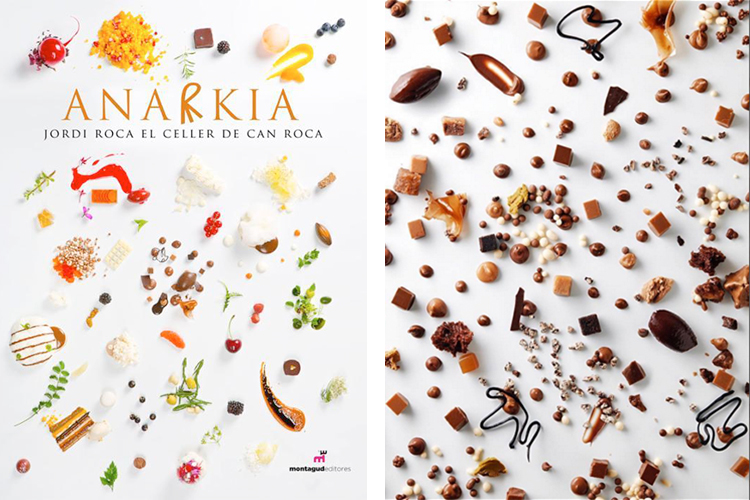
Book cover ‘Anarkia of Jordi Roca’ and dessert ‘Anarchy of chocolate’
Franc Aleu is a multidisciplinary artist, rather than an artist he is a project manager, an orchestra conductor and of all kinds of artists to do something sublime. He is the one who made El Somni and has made the Opera Samfaina.
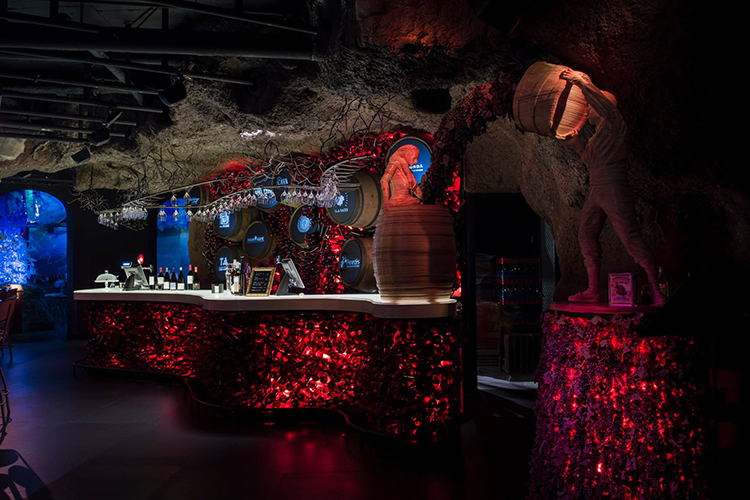
Wine Bar of Opera Samfaina, a gastronomic offer of the Roca brothers and Franc Aleu
Andreu Carulla is a well-known Banyoles designer. He is a crack solving the problems that I set him out and that he matures, he works in tandem with us.
Finally Neil Harbisson, a Catalan artist who lives in New York and interprets colors with songs. He was born with a dysfunction in sight and sees everything in black and white. 10 years ago, an antenna in his head was implanted and allows him to hear the colors, and thanks to it, he can perceive more colors than humans can. With him, we have made a cromograph a device to listen colors, and we are learning to fit it into table.
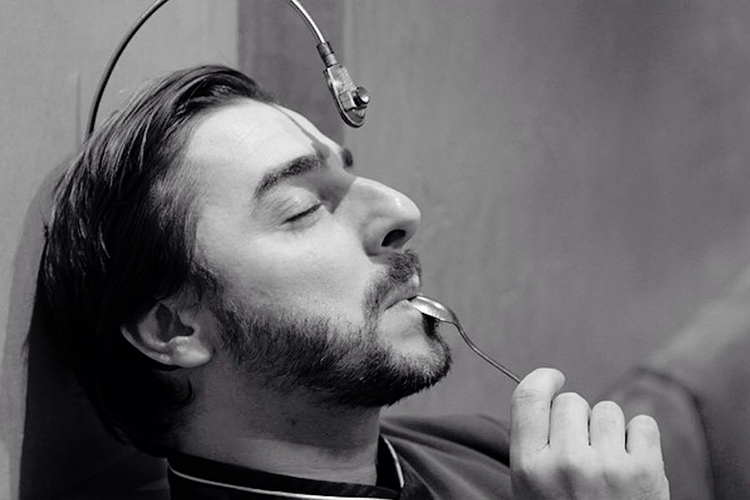
Jordi Roca with Neil Harbisson antenna, the first ‘cyborg’ of history
HORSE: Do you think avant-garde cuisine is an ephemeral art?
JORDI ROCA: Art understood as music, painting, culture… I look at it with great respect, admiration and fascination. It is not the same because it is now when we understand that in cuisine we can do different, transcendent and fun things. We use humor to get away a little of this goal, we have seen that in cuisine you can explain different stories and can maintain a connection with artistic worlds. Cuisine itself is power, is innovation, is science, is fun, is to convert, but sometimes it can become art by any means, as there are people behind that influence you.
HORSE: How do you see the current relationship between gastronomy and fashion?
JORDI ROCA: Before, I saw the world of fashion as something boring, I was not interested at all. When I inquired in the art world and saw how colors and the latest trends interact, how they change each year and how they evolve, I see a very interesting approach. I really like how dressmakers have done things with artists such as Takashi Murakami (I like him much more as an artist) did very funny things with Louis Vuitton. I started to be interested in Louis Vuitton from this collaboration.
HORSE: Will we ever have a dish of haute couture?
JORDI ROCA: Why not? It is a world that we can touch, as we have done with worlds that we would have never imagined to cover, such as sounds or music that was unthinkable and with Neil we have connected it. In fact, thanks to him we have met a talented young designer who made clothes for people with cyborgs and for people with technological concerns that go beyond.
“It is now when we understand that in cuisine we can explain different, transcendent and fun stories that can maintain a connection with artistic worlds”
HORSE: During this year, you have announced the creation of Roca Brothers Foundation, a post materialistic vision of social responsibility, environmental awareness and sustainability. What functions are going to play in the Foundation for these values?
JORDI ROCA: With the Foundation, we want to unite in the Masia del Celler several projects that we now have scattered, to be more agile and provide solutions and also be sustainable for us. There is a project called Roca Recicla, thanks to which we recycle glass bottles we use in the restaurant to make dishes, plates, spoons… We reconvert materials employing people who are at risk of social exclusion or who are old. The plates are not only used in the Celler, but we sell them in our world: in Morocco, the Opera Samfaina in the Omm Hotel… It is a project that has its own life and is financed by itself. We want to integrate it into Masia and the Foundation together with Terra Animada, the fact of recovering botanical species around Girona for use them in the kitchen.
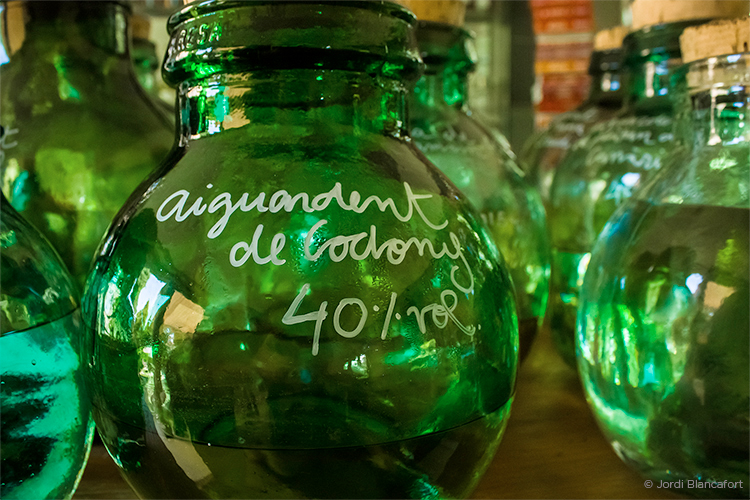
Bottles of moonshine of El Celler de Can Roca
The most powerful is that from this space of the Masia we have multidisciplinary people, such as a chemist focused on fermentation and food preservation: to make tempeh, to see how the mongetes de Santa Pau and the fesols ganxet ferment, to make gustatory evolutions in cooking, but also to relearn methods of conservation (preserves, vinegars, sauerkraut…) as vehicles to carry out UN projects. For example in Nigeria, a very poor area with lots of agriculture and where we have seen that 80% of what is produced in that area is thrown away because they know how to keep it. A year ago, we were appointed UN Goodwill Ambassadors, so everything that comes out of the UN will be linked to the Foundation, which we estimate will be established by the end of the year.
HORSE: Do you think there is a trend in haute cuisine towards models of sustainable restaurants such as the Azurmendi or the Relae in Copenhagen?
JORDI ROCA: Definitely. The more we learn about products, producers or proximity, the more we realize that we must look after what we have. To take care of what we need, we have to be sustainable and to be sustainable we must be efficient and minimize costs. Avant-garde cuisine brings us here. At the same time, we have the opportunity to be a speaker of what we do, so it is inevitable that we end up being efficient and sustainable, but we already are. We need to say it out loud so that more partners would be like this as well, because it is worth strengthen what we have around, enhance a prudence, kindest and caring cuisine for Earth. Everything goes to this point.
“The future restaurant will be the one that can make accessible a healthy and sustainable cuisine to many people as possible”
HORSE: The concept for which Magazine Horse identifies you during the month of November is EXPERIENCE, for your ability to offer unique and unforgettable experiences. What would be for you to live a unique and unforgettable experience?
JORDI ROCA: Make a stage in a Zen monastery, i.e. silence. When the day-to-day goes so fast, you do not have time to assimilate and internalize it, so I would like to stop and to rest it all.
HORSE: El Somni, your banquet opera in 12 acts, or Sublimotion, Paco Roncero’s restaurant, could be an example of audiovisual, avant-garde, multidisciplinary and multi-sensory experiences in the culinary scene. Is that how you see the fancy restaurants of the future?
JORDI ROCA: It is a way, in fact with El Somni we wanted to explain more things with food and make many arts of food interact. Whereupon, we understand that it is a path to the future restaurants. What happens is that is so elitist and so expensive to reproduce these restaurants, that I do not think that it is the format to succeed in the future. It is a format for a few, but not the one that will triumph. The one who will succeed will be the restaurant that is accessible by more people, which can make a healthy and sustainable cuisine accessible to many people as possible. This is the restaurant of the future, without any doubt.
HORSE: Your brother Joan said in an interview, “luxury is no longer wealth and ostentation. Luxury is the deal, excitement and hospitality. “What is luxury for you?
JORDI ROCA: I fully share the Joan’s point of view. Hospitality, to receive in person the customer who comes here from anywhere, being able to attend, feed him and make him feel at home, is valued more than technological elements or that worth a lot of money. What is impalpable, ephemeral, is much more valued today than something you can take. That is why people value so much Celler’s experience because you bring the memory of having experienced something real, something of the ground. You keep something in your mind that you have lived in privacy.
“Impalpable and ephemeral luxury, is much more valued today than something you can take”
HORSE: In Horse, we usually speak of special trips. For your work, you have been able to visit many places. What would you recommend to our readers travel and what is the next thing you have in mind?
JORDI ROCA: I love Tokyo as a destination because it is a vibrant city, it is amazing gastronomically and there are many restaurants, no one eats at home. Moreover, they are colorful, rare, and funny, people have fun eating. It is a destination where I have been three times and I want to go back because it is fun to live it and to be there and eat is priceless. In addition, it is not very expensive, the trip and the stay can be, but the food is cheap, for €30 you can have a festival with amazing seafood and fish. The funny thing is that in a street you can find a sushi restaurant, one of nigiri, another only of sashimi, chicken, ramen, kobe… They are very specialized and very interesting. Ice creams are also really good, they have all kinds of flavors and shapes.
As next destination, I would say Oaxaca. I know Mexico, my wife is Mexican, but I have not been to Oaxaca. It is a mystical and amazing place where the food is fascinating. An area where there are many ancient native tribes speaking dialects and pre-Columbian languages, there are still people who does not speak Spanish. I want to go because they have a very authentic cuisine that is only found in Oaxaca. In that area the native corn, of purple, blue, violet colors and with very different tastes of those we have here is still preserved. They have all kinds of insects and very good: there is a kind of ant making a nectar bubble with the honey that they collect and keep in their tail, which is like a candy. Vegetables cooked with old pots and firings…
HORSE: What do you usually do in your spare time to disconnect?
JORDI ROCA: Sleep. What I like is what I do, or eating or cooking.
HORSE: What is your color, your movie and your favorite book?
JORDI ROCA: I have been changing regarding to color. I really like the red but stresses me out. My favorite movie is a Japanese one that I have seen many times: “Spirited Away”. And the book is “Perfume” by Patrick Suskind.
As a colophon to this interview, we keep the phrase with which Jordi Roca announced the launch of the Brothers Rock Foundation: “Eating is the human expression of our world and its intangible forces of development: knowledge, culture, talent, creativity, health, solidarity, economy and diversity“. There is no doubt, Jordi Roca is EXPERIENCE.
Images from Jordi Blancafort and El Celler de Can Roca
Traductor: Raquel Sánchez

